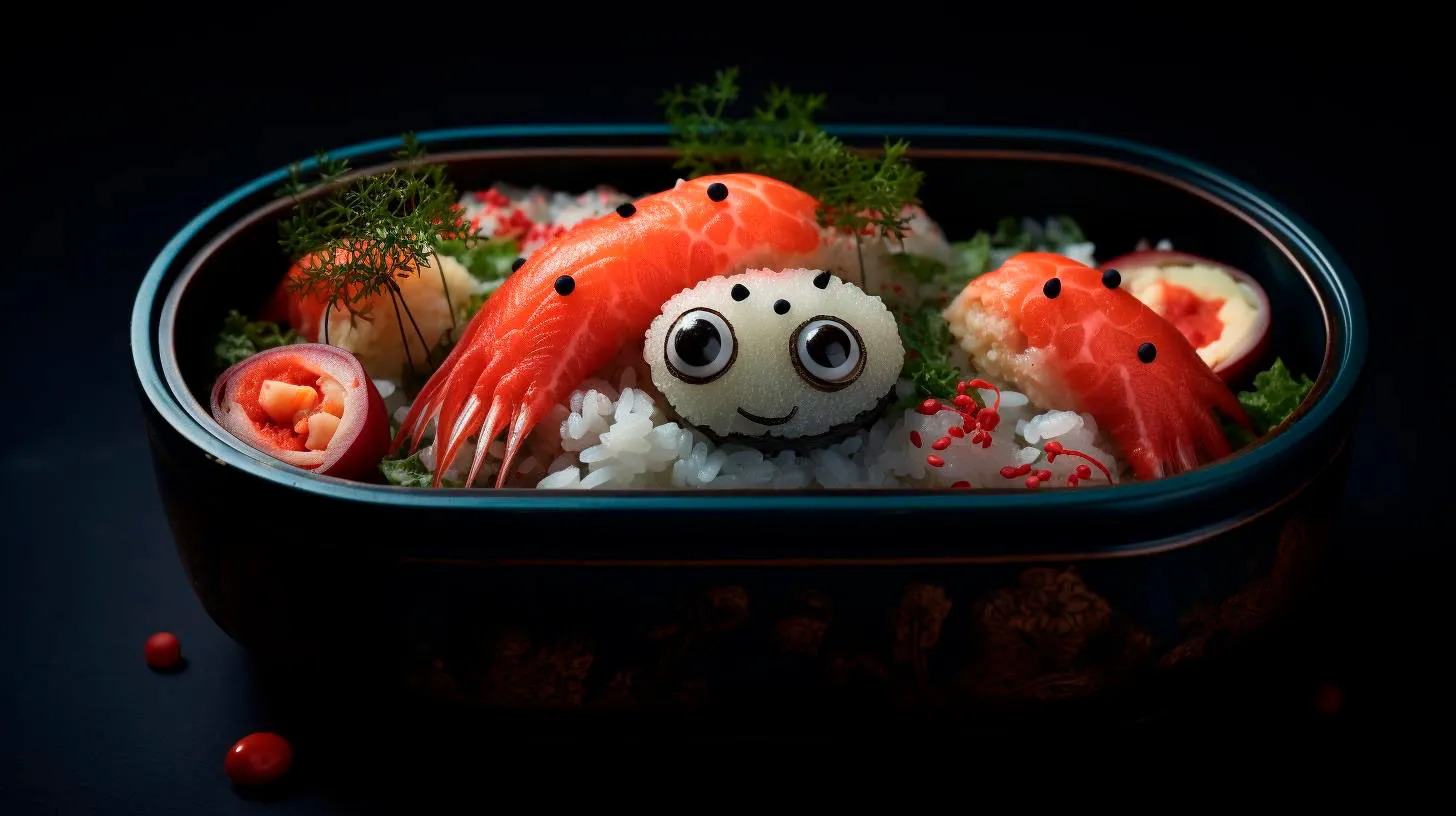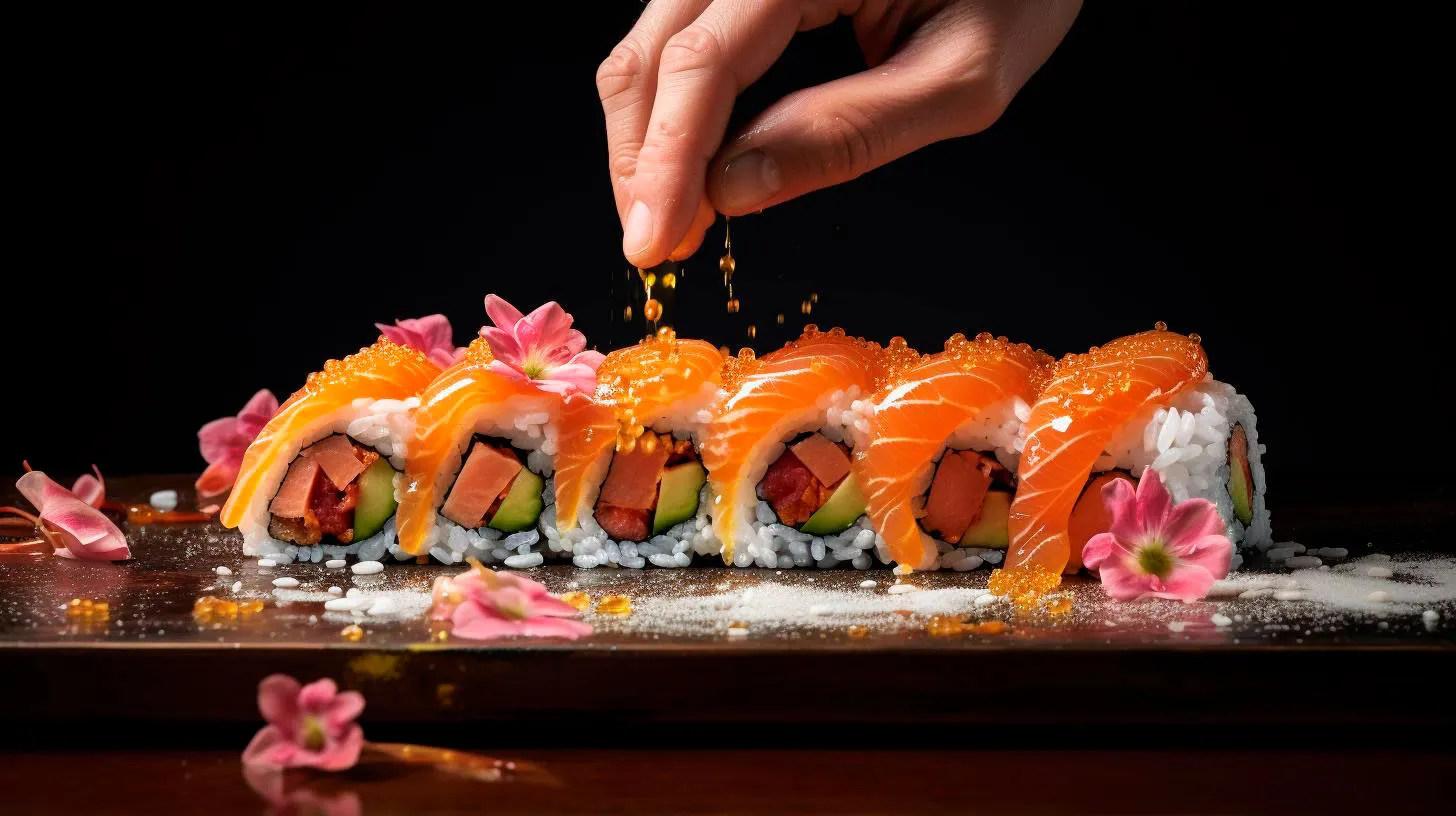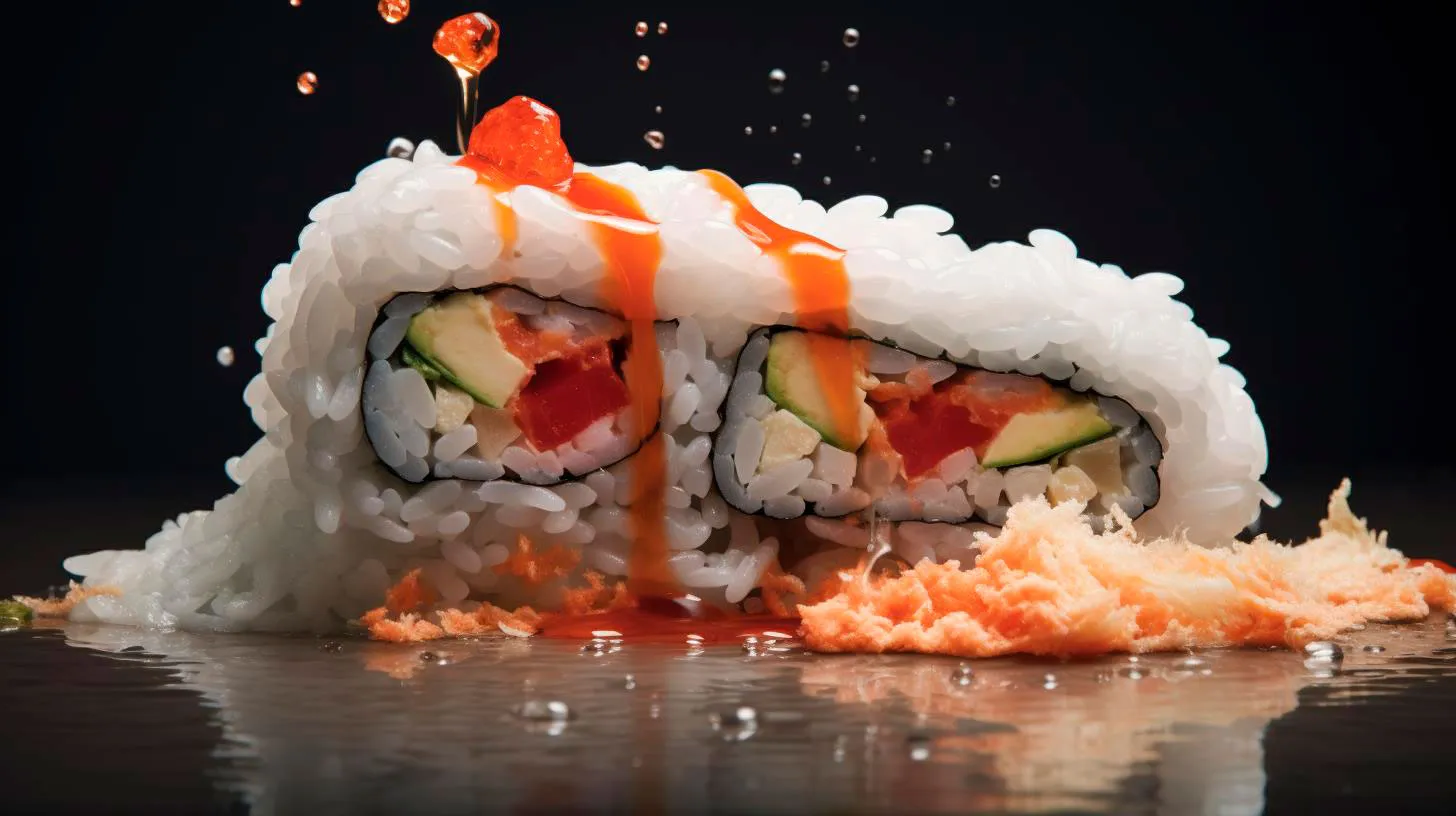Indulge in the Authentic Flavors of Sushi around the World
In this article, we will take a closer look at the authentic flavors of sushi from various regions, highlighting their unique characteristics and mouthwatering delicacies. So, let’s embark on a delightful sushi journey!
The Allure of Traditional Japanese Sushi
Japanese sushi, the birthplace of this delectable cuisine, offers a wide range of traditional flavors and techniques. Here are some key highlights:
- Maki-Zushi: This type of sushi consists of rice and various fillings rolled in seaweed (nori). It includes popular options like the classic California roll and the dynamic Dragon roll.
- Nigiri-Zushi: A simple yet elegant form of sushi, Nigiri-Zushi consists of a small mound of vinegared rice topped with a slice of raw or cooked fish. The balance between the rice and the topping is crucial to create the perfect flavor harmony.
- Sashimi: For those seeking an extraordinary culinary experience, sashimi is a must-try. It showcases fresh, raw fish or seafood slices, skillfully presented with garnishes for an enticing visual appeal.
Japanese sushi is known for its emphasis on minimalism, where chefs meticulously craft each piece to create a balanced flavor profile. The use of fresh, high-quality ingredients and precise techniques elevates the dining experience to a whole new level.
The Adventurous Fusion Sushi
As sushi traveled across the world and fused with local flavors, a new phenomenon emerged: fusion sushi. Combining the traditional art of sushi-making with a touch of creativity, fusion sushi has skyrocketed in popularity. Here’s what makes it so enticing:
- Unique Combinations: Fusion sushi often incorporates non-traditional ingredients like cream cheese, avocado, or mango, alongside traditional elements. These unexpected combinations create a delightful explosion of flavors.
- Specialty Rolls: One of the hallmarks of fusion sushi is the creation of specialty rolls. These oversized, intricate rolls often have playful names and mesmerizing presentations, adding to the overall dining experience.
- Modern Techniques: Fusion sushi also explores innovative techniques, such as tempura-fried rolls or using unconventional sauces, to offer a touch of culinary adventure.
Fusion sushi invites diners to embark on a gastronomic journey, where tradition meets innovation, resulting in extraordinary flavor combinations that appeal to the adventurous palate.
Exploring Sushi Beyond Japan
Sushi is now a global phenomenon, with each region adding its own flair to this beloved cuisine. Let’s explore some sushi hotspots and their highlights:
Hawaii: Tropical Fusion Bliss
Hawaiian sushi is a delightful blend of Japanese techniques and tropical ingredients. Some highlights include:
- Poke: This Hawaiian specialty combines raw fish, typically marinated in soy sauce and sesame oil, with vegetables, sauces, and seasonings. It offers a refreshing twist to traditional sushi.
- Local Ingredients: Hawaiian sushi showcases the abundance of fresh local seafood, including favorites like yellowfin tuna, mahi-mahi, and shrimp.
Peru: A Fusion of Japanese and Latin American Flavors
Peruvian sushi, or Nikkei cuisine, is a captivating blend of Japanese and Peruvian culinary traditions. Notable features include:
- Anticuchos: Popular in Peruvian cuisine, anticuchos are marinated, grilled skewers of meat or seafood, often served alongside sushi rolls to add a unique touch of smoky flavor.
- Spicy Infusions: Peruvian sushi is famous for its bold and vibrant flavors, with influences from the country’s love for spicy sauces like aji amarillo.
These are just a couple of examples, as sushi variations can be found in numerous other countries, each with their own delightful twists that celebrate local ingredients and cultural influences.
The Key Takeaway
Sushi’s journey from Japan to becoming a beloved international cuisine is a testament to its versatility and universal appeal. Whether you prefer the traditional flavors of Japan, the adventurous fusion creations, or the global interpretations, sushi provides an unparalleled culinary experience. So, next time you crave a sushi feast, experiment with different styles and flavors to indulge in the authentic taste of sushi from around the world.
From Tokyo to New York: A Culinary Journey through Sushi
The Origins of Sushi
Sushi, as we know it today, has a rich history that can be traced back to ancient Japan. The word “sushi” actually refers to the vinegared rice used in making the dish, not specifically to raw fish. The concept of sushi began as a preservation technique, where fish was stored in fermented rice for several months. Over time, this method evolved into the creation of nigiri sushi, where fresh fish was placed on top of seasoned rice, allowing the flavors to meld together.
The art of sushi-making was further refined in Tokyo during the 19th century, where sushi chefs focused on perfecting the balance of flavors, textures, and presentation. Today, Tokyo remains one of the world’s culinary capitals, renowned for its exceptional sushi.
Sushi Rolls: A Global Phenomenon
When sushi made its way to the United States in the mid-20th century, it underwent a transformation to suit the local palate. The introduction of the California roll, which replaced raw fish with avocado, cucumber, and crab stick, made sushi more accessible to those who were not accustomed to raw seafood.
From there, sushi rapidly gained popularity and began to appear in various forms across different countries. Unique and innovative sushi rolls have emerged, incorporating regional flavors and ingredients. In New York City, for example, you can find sushi rolls with a fusion twist, such as the spicy tuna roll and the rainbow roll.
Sushi’s Health Benefits
One of the key reasons for sushi’s widespread popularity is its reputation as a healthy cuisine. Sushi is generally low in calories and saturated fats, making it an ideal choice for those who want to maintain a balanced diet. The use of fresh, high-quality ingredients, such as fish, seaweed, and vegetables, provides a rich source of essential nutrients and omega-3 fatty acids.
Additionally, sushi is often served with pickled ginger, wasabi, and soy sauce. Ginger aids in digestion, while wasabi possesses anti-inflammatory properties. Soy sauce, although high in sodium, can be used in moderation to enhance the flavors of the sushi.
The Art of Sushi Making
Creating sushi is an art form that requires years of practice and skill. Skilled sushi chefs meticulously select the freshest ingredients, paying attention to the texture, flavor, and appearance of each component. Every piece of sushi is carefully shaped by hand to ensure the perfect balance between the rice and topping.
Key Takeaways:
- Sushi originated in Japan where it was initially used as a preservation technique.
- Tokyo remains a culinary capital renowned for its exceptional sushi.
- Sushi transformed in the United States, leading to the creation of innovative rolls.
- Sushi is a healthy cuisine due to its low calorie and saturated fat content.
- Sushi-making is an intricate art form that requires skill and practice.
Sushi’s Global Popularity
Sushi’s popularity extends far beyond Japan and the United States, with its presence now felt in many parts of the world. Here are some interesting statistics that highlight its global appeal:
- Europe consumes over 40,000 tons of sushi annually.
- Australia has experienced a sushi boom, with a 320% increase in sushi consumption over the past decade.
- In Brazil, sushi has become a staple in many cities, with more than 1,000 sushi restaurants in São Paulo alone.
- In Singapore, sushi is a favorite dish among locals, with sushi bars and conveyor belt sushi restaurants found in almost every corner.
The global popularity of sushi can be attributed to its unique combination of flavors, textures, and visual appeal. Whether you’re in Tokyo or New York, there’s always a sushi experience waiting to tantalize your taste buds.
In Conclusion
Sushi has transcended cultural barriers, leaving an indelible mark on the culinary landscape of the world. From its humble origins in Japan to its evolution into a global phenomenon, sushi has become a favorite choice for people seeking a healthy and flavorful meal. As you embark on your own culinary journey, be sure to savor each bite and appreciate the artistry behind this beloved delicacy.
Discover the Intriguing Stories Behind Famous Sushi Locations
In this article, we will take a closer look at these stories that have shaped the sushi culture and made these locations stand out.
The Birth of Sushi
Sushi, as we know it today, has its origins in Japan. It was first mentioned in written records in the 8th century, and it has evolved significantly throughout history. Originally, sushi was not intended to be consumed but rather used as a preservation method. Fish was fermented with rice and salt, allowing it to last for months or even years.
Eventually, this preservation method was refined and developed into the sushi we enjoy today. The fish was no longer fermented but instead served fresh. This transition occurred during the Edo period in Japan, around the 19th century, thanks to the advances in refrigeration technology.
The Tsukiji Fish Market in Tokyo
One of the most famous sushi locations in the world is the Tsukiji Fish Market in Tokyo, Japan. This vibrant market has a rich history that dates back to the 16th century. It started as a simple fish market and gradually grew into the largest wholesale fish market in the world.
For sushi lovers, visiting the Tsukiji Fish Market is a dream come true. Not only can you witness the bustling atmosphere of the market, but you can also taste some of the freshest sushi available. Many renowned sushi chefs source their ingredients from the Tsukiji Fish Market, ensuring that their creations are of the highest quality.
Key takeaways:
- The Tsukiji Fish Market in Tokyo is the largest wholesale fish market in the world.
- Renowned sushi chefs source their ingredients from Tsukiji Fish Market.
- Visiting the market offers an opportunity to taste incredibly fresh sushi.
Sukiyabashi Jiro: A Culinary Legend
Another famous sushi location that has captivated sushi enthusiasts worldwide is Sukiyabashi Jiro, a small restaurant located in Tokyo. This legendary sushi establishment has been awarded three Michelin stars and is considered one of the best sushi restaurants in the world.
Sukiyabashi Jiro was founded by Jiro Ono, a sushi master who dedicated his life to perfecting his craft. With more than 50 years of experience, Jiro has become an icon in the sushi world. His attention to detail, precise techniques, and dedication to quality have made Sukiyabashi Jiro a must-visit destination for sushi lovers.
Key takeaways:
- Sukiyabashi Jiro is a renowned sushi restaurant in Tokyo with three Michelin stars.
- The founder, Jiro Ono, is a sushi master with over 50 years of experience.
- Attention to detail and dedication to quality are the hallmarks of Sukiyabashi Jiro.
Nobu: A Fusion of Tradition and Innovation
While traditional sushi holds a special place in the hearts of sushi connoisseurs, there are also sushi locations that have taken a more innovative approach. Nobu, a world-famous sushi restaurant founded by chef Nobu Matsuhisa, is a prime example.
Combining traditional Japanese flavors with a touch of South American and Western influences, Nobu has created a unique culinary experience. With locations all around the world, including New York, Tokyo, and London, Nobu has introduced sushi to a wider audience while maintaining a high standard of quality.
Key takeaways:
- Nobu is a globally recognized sushi restaurant that blends traditional Japanese flavors with international influences.
- Chef Nobu Matsuhisa has brought sushi to a broader audience through his innovative creations.
- Nobu maintains a high standard of quality across its various locations.
The Remarkable Stories Continue
These are just a few examples of the intriguing stories behind famous sushi locations. From traditional sushi masters to innovative culinary experiences, the world of sushi is filled with rich history and exciting tales. Exploring these locations and discovering their stories adds extra flavor to the already delightful experience of enjoying sushi.
Unveiling the Rich Heritage of Sushi in Different Cultures
The Origins of Sushi
Sushi, as we know it today, has its origins in Japan. It dates back to the 8th century when it was introduced as a way to preserve fish. Initially, the fish was marinated in fermented rice, which was discarded before eating the fish. Over time, the rice began to be consumed along with the fish, resulting in the sushi we know and love.
- Key Takeaway: Sushi originated in Japan in the 8th century as a method of preserving fish.
Sushi in Japan
In Japan, sushi is more than just a dish; it is an art form. Traditional sushi in Japan is characterized by its simplicity and focus on the flavors of the fish. The rice plays a subsidiary role and is seasoned with vinegar. Common types of sushi in Japan include nigiri, maki, and temaki.
- Key Takeaway: Traditional sushi in Japan emphasizes the flavors of the fish, with the rice playing a complementary role.
Sushi in America
In the early 1900s, Japanese immigrants introduced sushi to the United States. However, it wasn’t until the 1960s and 1970s that sushi gained popularity and became more widespread. American sushi has adapted to local tastes and includes variations such as the California roll, which features avocado, cucumber, and crabmeat.
- Key Takeaway: American sushi has evolved to include local flavors and ingredients, such as the California roll.
Sushi in Brazil
Brazil has its own unique take on sushi, known as “sushi brasileiro.” Brazilian sushi often includes tropical fruits like mango and passion fruit as well as ingredients like cream cheese and tempura batter. This fusion of flavors creates a vibrant and flavorful sushi experience.
- Key Takeaway: Brazilian sushi incorporates tropical fruits and ingredients like cream cheese, creating a unique and vibrant flavor profile.
Sushi in Other Cultures
As sushi gained popularity worldwide, different cultures put their own spin on this beloved dish. In Hawaii, for example, sushi is often made with spam as a filling, reflecting the island’s history and influences from Japanese and American cuisines. In Scandinavia, sushi is sometimes made with local fish like salmon and herring.
- Key Takeaway: Sushi has been adapted in various ways to suit the local tastes and ingredients of different cultures.
Health Benefits of Sushi
Aside from its cultural significance, sushi is also celebrated for its health benefits. As a seafood-based dish, sushi is rich in omega-3 fatty acids, which are known to promote heart health. Additionally, the seaweed used in sushi is a great source of fiber, vitamins, and minerals.
- Key Takeaway: Sushi is not only delicious but also offers potential health benefits due to its seafood and seaweed components.
Conclusion
Sushi is a culinary delight that has transcended its origins in Japan and found a place in the hearts and dining tables of people around the world. From traditional preparations in Japan to fusion creations in Brazil and adaptations in other cultures, sushi continues to evolve while retaining its cultural significance. Whether you prefer classic nigiri or enjoy exploring creative sushi rolls, there is something for everyone to enjoy in the diverse world of sushi.



